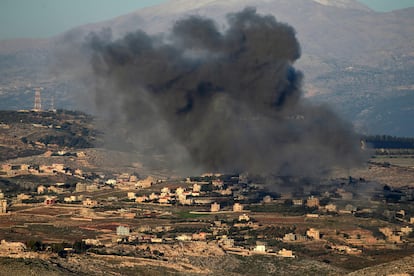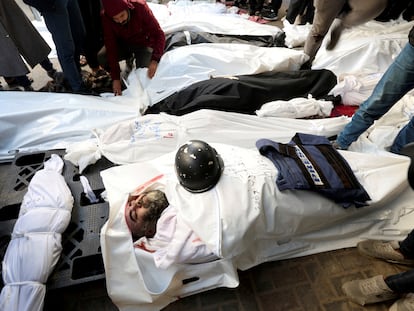Iran, Yemen, Syria, Lebanon, Iraq, West Bank... Israel says the Gaza war is now being fought on seven fronts
The Israeli Minister of Defense claims that his army has responded to aggression in six countries since the October 7 attacks. Tehran accuses Israel of assassinating a Revolutionary Guard general in Syria

Eighty-one days after the start of Israel’s war against Hamas in Gaza, the conflict is increasingly taking on a regional scale. On Tuesday, Israel’s Minister of Defense Yoav Gallant told the Israeli Parliament’s Defense Committee that the country is fighting on seven fronts and has responded to attacks in six of them thus far. In addition to the Gaza Strip, where nearly 21,000 people have already died, and the West Bank — which Gallant referred to as “Judea and Samaria” and where incursions occur almost daily — the minister said that hostilities have spread to Iran, Yemen, Syria, Lebanon and Iraq. “I’m saying it here explicitly,” Gallant warned during his speech. “Anyone who acts against us as a potential target will not be immune.”
Until Monday, Israel’s clashes beyond its borders and those of the occupied territories had been limited to secondary actors allied with Iran, such as Hezbollah in Lebanon, whose attacks on the north of the country have forced tens of thousands of Israelis to evacuate. But two days ago, Tehran accused the Israeli Defense Forces of assassinating Iranian Revolutionary Guard General Razi Mousavi and three others by firing several missiles while he was in Sayyidah Zaynab, a neighborhood south of Damascus, the Syrian capital. Israel has not confirmed its involvement in the attack, but it accused the Iranian general of trafficking arms from Iran and financing Lebanese Shiite guerrillas and other Islamist organizations in Syria.
Iranian public television interrupted its broadcast to break the news. The country’s president, Ebrahim Raisi, said that the attack was “a sign of the frustration and weakness of the Zionist regime, for which it will surely pay a price.” For its part, the Iranian Revolutionary Guard issued a statement that was similar in tone. “Undoubtedly, the savage usurper Zionist regime will pay for this crime,” it said in the press release, which predicted “suffering” for Israel. Mousavi was responsible for coordinating the military alliance between Syria and Iran, as well as one of the main collaborators of Qasem Soleimani, the head of the Quds Force (Iran’s intelligence and asymmetric warfare unit), killed by the U.S. in a drone strike on January 3, 2020, in Baghdad, Iraq.
If it is confirmed that Israel was responsible for the senior Iranian military officer’s death, that would mean an escalation in the conflict. Thus far, Tehran has not taken any direct action against Israel; it has only increased its threatening rhetoric. Since October 7, Iran has stepped up its activity against Israel considerably, by funding and arming not just Shiite militias in Lebanon and Syria but also the Houthi rebels in Yemen. The International Atomic Energy Agency has warned that in recent weeks Israel’s arch-enemy Iran has tripled production of enriched uranium to 60%, below the 90% needed to make atomic weapons but well above the 3.67% maximum imposed by the agreement on its 2015 nuclear program, which the United States unilaterally abandoned three years later.
Gallant mentioned Yemen as another front in the war. Since the conflict began, the Iranian-sponsored Houthi guerrillas have launched several drone attacks against southern Israel. For weeks now, they have been harassing ships crossing the Red Sea, forcing the U.S. to organize a multinational force to confront them and facilitate maritime traffic to and from the Suez Canal.
The latest two incidents in that area just occurred on Tuesday. The U.K. Merchant Navy’s maritime authority recorded two explosions and announced the sighting of two drones within five nautical miles of a ship traveling off the coast of the Yemeni port of Al-Hudaydah. Missiles hit another vessel in the same area. The rockets landed half a mile and four miles away. The same source confirmed that the missiles did not damage the cargo ship and that the crews did not suffer any casualties.
On the Lebanese front, Israel once again attacked Hezbollah targets in the south of the country in the umpteenth skirmish between the two sides since the October 7 attacks. According to a military spokesman, the Israeli Defense Forces responded to the launch of an anti-tank missile that hit the St. Mary’s Orthodox Church in the Israeli town of Iqrit on the Lebanese border. Nine Israeli soldiers were wounded in the attack, one of whom is in serious condition. Hezbollah rockets also hit an agricultural cooperative in the Israeli town of Dovev.
On the Iraq front, the United States military acted on Monday after the pro-Iranian Kata’ib Hezbollah militia attacked the U.S. base in Erbil by dropping a drone on it that left one U.S. soldier in critical condition and wounded two others. That was not the first attack on Erbil and other U.S. military installations in Iraq and Syria since Oct. 7. “These attacks are intended to hold perpetrators accountable and damage their ability to continue attacks. We will always protect our forces,” General Michael Kurilla, the head of U.S. Central Command, said in a press release, as quoted by Reuters.
Sign up for our weekly newsletter to get more English-language news coverage from EL PAÍS USA Edition
Tu suscripción se está usando en otro dispositivo
¿Quieres añadir otro usuario a tu suscripción?
Si continúas leyendo en este dispositivo, no se podrá leer en el otro.
FlechaTu suscripción se está usando en otro dispositivo y solo puedes acceder a EL PAÍS desde un dispositivo a la vez.
Si quieres compartir tu cuenta, cambia tu suscripción a la modalidad Premium, así podrás añadir otro usuario. Cada uno accederá con su propia cuenta de email, lo que os permitirá personalizar vuestra experiencia en EL PAÍS.
¿Tienes una suscripción de empresa? Accede aquí para contratar más cuentas.
En el caso de no saber quién está usando tu cuenta, te recomendamos cambiar tu contraseña aquí.
Si decides continuar compartiendo tu cuenta, este mensaje se mostrará en tu dispositivo y en el de la otra persona que está usando tu cuenta de forma indefinida, afectando a tu experiencia de lectura. Puedes consultar aquí los términos y condiciones de la suscripción digital.
More information
Archived In
Últimas noticias
Welcome to the post-religion era: The idea of Christianity as the absolute truth has become obsolete
‘I thought you would like it’: The risky sexual practice popularized by TV shows and TikTok
The digitalization of tourism: ‘They promise experiences and gave us the worst possible one’
Mexican peso defies uncertainty with forecasts of a new period of stability in 2026
Most viewed
- Sinaloa Cartel war is taking its toll on Los Chapitos
- Reinhard Genzel, Nobel laureate in physics: ‘One-minute videos will never give you the truth’
- Oona Chaplin: ‘I told James Cameron that I was living in a treehouse and starting a permaculture project with a friend’
- Why the price of coffee has skyrocketed: from Brazilian plantations to specialty coffee houses
- Silver prices are going crazy: This is what’s fueling the rally










































